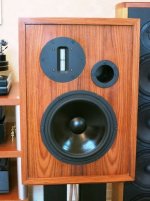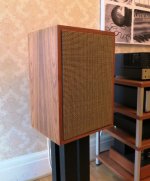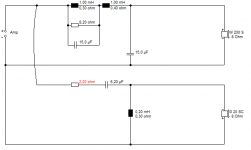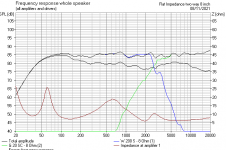The SPH-220HQ is quite a nice driver. I used it in a couple of designs a few years back, including the 2-way standmount attached. The ribbon was a mistake -crossing to an 8in at about 2.8KHz was asking too much of it. Were I to revisit (no chance now, sadly) I'd go with a quality dome as the partnering HF driver. No regrets over the 220HQ though -excellent unit of its type for the money. And Colin's cabinet work went some way to making up for a slightly overwrought tweeter. 😉
Attachments
Last edited:
The SPH-220HQ is quite a nice driver. I used it in a couple of designs a few years back, including the 2-way standmount attached. The ribbon was a mistake -crossing to an 8in at about 2.8KHz was asking too much of it. Were I to revisit (no chance now, sadly) I'd go with a quality dome as the partnering HF driver. No regrets over the 220HQ though -excellent unit of its type for the money. And Colin's cabinet work went some way to making up for a slightly overwrought tweeter. 😉
They do look nice. I had similar problems trying to mate a midbass driver to a ribbon tweeter, so I feel your pain 🙂
Weren't you the brains behind the Edingdale speakers? If so, Is your partnership with Colin still going? I've not seen any mention of his speakers lately.
This thread has me contemplating getting the soldering iron out again. Wish I kept better records of what seemed to win a cigar and what didn't. Small changes can transform the sound in my experience. A liitle 6kHz tank notch (usually about 22R and 0.68uF) on a 1mH bass coil, for instance.
I have related before how I was amazed at how good this old 8" Wharfedale Shelton was:
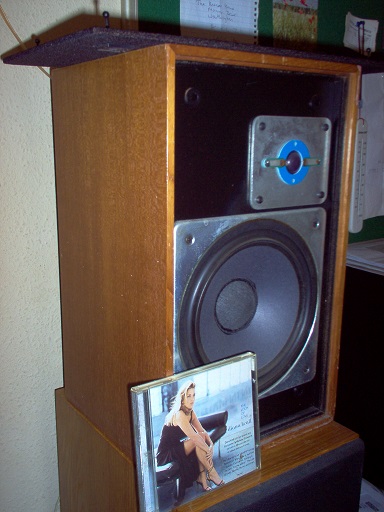
A bit more to the crossover than usual:
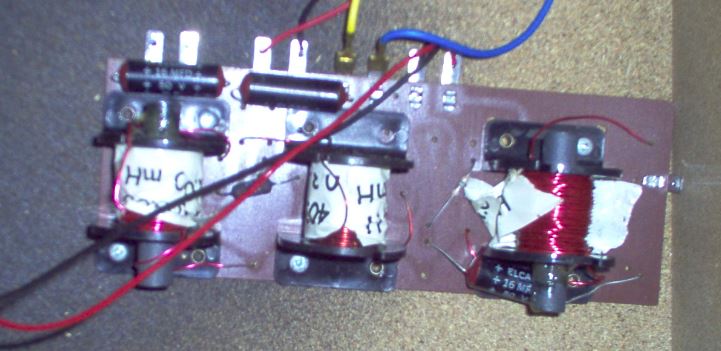
https://www.diyaudio.com/forums/multi-way/314732-wharfedale-shelton-xp2-minor-classic-imo-2.html#post5429893
I was simming it today. Quite remarkable circuit. Sort of thing the BBC and KEF used to do. The 3/4" polyester dome tweeter probably benefits from the grille cloth, being famously bright at the top. The LCR notch around 1kHz seems to keep the paper woofer well behaved despite high inductance.
I have related before how I was amazed at how good this old 8" Wharfedale Shelton was:
A bit more to the crossover than usual:
https://www.diyaudio.com/forums/multi-way/314732-wharfedale-shelton-xp2-minor-classic-imo-2.html#post5429893
I was simming it today. Quite remarkable circuit. Sort of thing the BBC and KEF used to do. The 3/4" polyester dome tweeter probably benefits from the grille cloth, being famously bright at the top. The LCR notch around 1kHz seems to keep the paper woofer well behaved despite high inductance.
Attachments
Fair bit of mission creep here... 😀
Открытые проекты | difton
That's an interesting project. I have played with similar stuff myself. Standard 3.5kHz 3.9uF/0.33mH crossover by the look of it.
I used first order with impedance correction on the bass, with the cheaper Morel CAT 298 tweeter, but negative polarity again.
We had a look at the Seas CA22RNX a while back. Pano got involved IIRC.
The 2.2mH/6.8uF seemed to work well enough with the lowish inductance SEAS woofer. Dissi had a look at it on sim. Said it was OK.
He states that it has a 3khz crossover point. Interrestingly enough my Patos 401 had the exact same crossover on the tweeter as this Difton speaker. But that is MDT32S instead of the CAT308. Only it was connected with postive polarity. I inverted the polarity and it sounded so much better.
The crossover on the P21 woofer is 1,2mH series with 6,8uF/1ohm shunting. And it sounds great in my highly subjective view 😀
They do look nice. I had similar problems trying to mate a midbass driver to a ribbon tweeter, so I feel your pain 🙂
It certainly confirmed that I'm not a huge fan of ribbons. 😉 I like what they do well, but on the whole I prefer a quality dome. A useful learning experience on the whole. They didn't sound bad at all (pretty good in the scheme of things) but we were never completely happy.
Weren't you the brains behind the Edingdale speakers? If so, Is your partnership with Colin still going? I've not seen any mention of his speakers lately.
I don't know about 'brains' but in effect, yes, I designed them, although to say that is also an over-simplification and I want to give fair distribution of any credit that may or may not be involved. We selected the drivers together, I did the box & crossover design, Colin the CAD work, construction & finishing. Final voicing was a mix of ourselves with some input from our friend Chris, and sometimes from Nick (of Longdog Audio), & another friend Andrew when he was able to get down from Scotland. It was Nick who originally suggested the semi-array configuration.
Colin has mostly retired from active speaker building as far as I know, although I suspect if anybody asked nicely, he'd build them a pair of Edingdale GTs, which was our top model.
I know Harbeth doesn’t use aluminum cones but the RS225-8 should get a close look. It’s absolutely flat and well behaved and has a breakup way up at 7kHz which is easy to filter out. It’s also very low distortion. IMO, it’s one of the best 8in woofers at any price. Very easy to integrate with a tweeter or mid range.
The paper version interests me more as I have heard it in an ALTA speaker. But you are right thay are fairly easy to integrate. The only thing to beware of is their sensitivity ratings are optimistic
Jeff Bagby loved the 5in unit in his Continuum as I recall. However, AC sometimes seem to have an issue with QC / QA. Jim & Curt pulled their Bordeaux because of consistency problems with the AMT tweeter they used, and back when he was doing driver testing, Zaph noted the same with the 6 1/2in AC180 he had in, and wasn't especially impressed with the 8in AC200MKII either -not a bad response if you're pitching for a relatively low crossover frequency, but HD in the ~600Hz - 700Hz region isn't so hot.
Thanks Scotty, 🙂 These are all nuggets of info that you very experienced guys know that are very helpful. I cant thank everyone enough!!
I just got back from Capital Audiofest and was not very impressed by some of the speakers there. The ones that impressed me were:
SALK S3 (new model)
Tidal speakers
and the best in show for me was KHARMA.
Jg
So do they. As I recall, Harbeth run (or ran) the two tweeters off the same high pass, and if there was a low-pass on the larger of the two, the Stereophile measurements imply it wasn't doing a great deal.
Unless you can afford to stump up for AudioTechnology units, which are firmly in the 'if you have to ask...' category, or find a Tymphany built edition of the old Vifas, then as has been suggested, you're probably looking at the 8in Scan Discoveries or the Seas U22 as the nearest equivalents to what Harbeth have, with a Seas Excel tweeter, & a crossover lurking in the 2.5KHz region, give or take a few hundred Hz.
Holy crap the AT units are $500 each lol. Ok so thats a bit much ha ha
Audax HM210C0 8" Carbon Fiber Woofer
..I'd also choose the SB STAC tweeter (..but then I'd choose that tweeter over most anyway.)
SB Acoustics SB26STAC-C000-4 1" Textile Dome Tweeter
..I'd also choose the SB STAC tweeter (..but then I'd choose that tweeter over most anyway.)
SB Acoustics SB26STAC-C000-4 1" Textile Dome Tweeter
Last edited:
The paper version interests me more as I have heard it in an ALTA speaker. But you are right thay are fairly easy to integrate. The only thing to beware of is their sensitivity ratings are optimistic
I find Dayton specs to be honest and realistic. They have the most accurate Qts specs even better than a well known Scandinavian brand.
I have tried the paper cone RS180-8 and I have to say the aluminum RS180-8 sounds better and has better bass due to lower Fs.
Agreed re the alloy versions, although I can only live with them with relatively high order filtering myself. Unfortunately, being PE's 'house brand' the value tends to drop away outside the US, which can be a consideration for some. For e.g., being in the UK, by the time shipping, import duty, local taxes etc. are factored in, they can cost more than the equivalent Seas or Scan. 

That is the reason I took the Sb23NBAC at compacbel Belgium. Cheap and fast free shipping within EC. And it has a smoothnsound for an Al. Idem than Xrq input, the little 6" brother is better overall as per what happens for Dayton. The SB23 though has to be seen as a bass unit and not a woofer. So 3 way. The Dayton could be a much better unit for a two ways. Less highs break up, less eficienty too. But could perhaps live with a 1.2 corundum tweeter from peereless for a XO from 18 dB to 24 dB...around 1500 hz
Last edited:
Joachim Gerhard said he got it working with just a coil.
He also thought it went well with the DXT tweeter on just a capacitor!
Is the XO published? I would like to see what it looks like.
Myself and speaker genius Troels Gravesen have had frequent forum spats about his rapacious commercialisation of what, to me, is merely an interesting hobby in search of a better sound from my affordable projects.
Very little flies past my radar on mention of Hilbert Transforms and Dirac Delta functions!
Troels is currently "upgrading" his commendable free projects in favour of money-spinning LR2 (12dB/octave) and questionable and difficult time-alignment carpentry. 😡
What forum does Troels frequent?
Myself and speaker genius Troels Gravesen have had frequent forum spats about his rapacious commercialisation of what, to me, is merely an interesting hobby in search of a better sound from my affordable projects.
Very little flies past my radar on mention of Hilbert Transforms and Dirac Delta functions!
Troels is currently "upgrading" his commendable free projects in favour of money-spinning LR2 (12dB/octave) and questionable and difficult time-alignment carpentry. 😡
Hi, why do you think stepped baffle is questionable? I don't have beef neither with Troels or you, i bought and made one of his speakers discovery 861 that did use stepped baffle and i honestly think it is excellent speaker for the price. But i admit i get the feeling that his answers seem to be little too much in "guarded side" like he thinks what his sponsors might think if he says he likes one thing over other..
I don't know, hard to tell for real hough..
Hi Scott.The SPH-220HQ is quite a nice driver. I used it in a couple of designs a few years back, including the 2-way standmount attached. The ribbon was a mistake -crossing to an 8in at about 2.8KHz was asking too much of it. Were I to revisit (no chance now, sadly) I'd go with a quality dome as the partnering HF driver. No regrets over the 220HQ though -excellent unit of its type for the money. And Colin's cabinet work went some way to making up for a slightly overwrought tweeter. 😉
Sorry to bother you a bit, but you seem to be only person i know that has built with monacor 220hq drivers.. so
Thing is i have been trying to find midwoofer that has smooth warm qualities. My search has gone into two options, Revelator w18/8531g00/4531g01 and monacor sph 220hq, i think you have heard them both?
(i read somewhere here on you commenting on revelator w18 midwoofers)
If you can comment on them, which is smoother, and which is more detailed (i am extremely sensitive to sibilance, even in middrivers..)
I would appreciate it a lot, thanks!
My number 1 option is now revelator, but i found pair of sph 220 for very cheap, so i thought should i buy them both and compare myself, are they that different?
Best regards
Jarkko
Sorry, but what speakers were finally used on this Harbeth clone?
Why was the Peerless NE225W-08 replaced by the Monacor SPH220 HQ, as the specs and curve looks more promising on the former? New measurements or listenings?
Why was the Peerless NE225W-08 replaced by the Monacor SPH220 HQ, as the specs and curve looks more promising on the former? New measurements or listenings?
Sorry for bringing up this old thread.
....So a shady facebook page indicated that the Harbeth RADIAL drivers were simply Audax´s Aerogel membrane.
Could it be?
Well, it does look close, Audax describes Aerogel as "acrylic polymer gel in which an optimized portion of Carbon and Kevlar fibres are embedded.". That sounds almost as the description of the RADIAL technology.
All respect to Alan Shaws beautiful speakers, and in one of the ´factory visit´videos earlier in this thread, you do see one guy gluing together he genuine Harbeth drivers, so it is probably only the membrane itself that is Audax Aerogel and not the whole driver, which would also make it perfectly accepted for Harbeth to call it their own driver.
But maybe we can get there too in DIY.
I recently replaced the drivers in one of my two DIY pairs of LS3/5a with Audax HM130Z12, and Vifa D19 aluminium tweeters, and trimmed the crossover to perfection.
I have never heard the proper Harbeth LS3/5a, but my rebulids sounds really nice, and much much clearer than the other pair with the old KEF drivers.
So for getting close to the Harbeth version of BBC LS5/9 ( M30) one might look at Audax HM210.
Now this one comes in different versions:
HM210Z0, which looks very smooth, but rolls of naturally at 2.4kHz ( ...which is also the crossover frequency for BBC LS5/9 and Harbeth M30).
There is also a HM210Z2 which goes to 3,5 kHz, but looks really nasty in the waterfall curve from the datasheet.
There are also HM210Z10 and HM210Z12.
What say the experts: Will Audax HM210Z0 be good enough?
Does it also need one extra pole to fit the '2nd order bass, 3rd order tweeter' dogma?
Or could one leave the bass with it´s natural roll off, and lower the tweeter filter to 2nd order for the proper 90 degrees phase-difference?
...I am a little concerned if the unregularities in the waterfall spectrum for HM210Z0 right after the 2.4khz will be audible.
....So a shady facebook page indicated that the Harbeth RADIAL drivers were simply Audax´s Aerogel membrane.
Could it be?
Well, it does look close, Audax describes Aerogel as "acrylic polymer gel in which an optimized portion of Carbon and Kevlar fibres are embedded.". That sounds almost as the description of the RADIAL technology.
All respect to Alan Shaws beautiful speakers, and in one of the ´factory visit´videos earlier in this thread, you do see one guy gluing together he genuine Harbeth drivers, so it is probably only the membrane itself that is Audax Aerogel and not the whole driver, which would also make it perfectly accepted for Harbeth to call it their own driver.
But maybe we can get there too in DIY.
I recently replaced the drivers in one of my two DIY pairs of LS3/5a with Audax HM130Z12, and Vifa D19 aluminium tweeters, and trimmed the crossover to perfection.
I have never heard the proper Harbeth LS3/5a, but my rebulids sounds really nice, and much much clearer than the other pair with the old KEF drivers.
So for getting close to the Harbeth version of BBC LS5/9 ( M30) one might look at Audax HM210.
Now this one comes in different versions:
HM210Z0, which looks very smooth, but rolls of naturally at 2.4kHz ( ...which is also the crossover frequency for BBC LS5/9 and Harbeth M30).
There is also a HM210Z2 which goes to 3,5 kHz, but looks really nasty in the waterfall curve from the datasheet.
There are also HM210Z10 and HM210Z12.
What say the experts: Will Audax HM210Z0 be good enough?
Does it also need one extra pole to fit the '2nd order bass, 3rd order tweeter' dogma?
Or could one leave the bass with it´s natural roll off, and lower the tweeter filter to 2nd order for the proper 90 degrees phase-difference?
...I am a little concerned if the unregularities in the waterfall spectrum for HM210Z0 right after the 2.4khz will be audible.
Attachments
- Home
- Loudspeakers
- Multi-Way
- Woofer suggestion for Harbeth like 2 way
